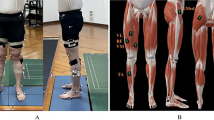Abstract
Objective
The aim of this study was to compare activation levels of rectus femoris, biceps femoris, tibialis anterior, and soleus muscles and biomechanical properties of individuals with muscle disease and healthy individuals during sit-to-stand.
Methods
Fifteen patients (11 muscular dystrophy, 4 myopathy) and 15 healthy individuals were included in the study. A Noraxon superficial electromyography device and high-speed cameras were used to evaluate muscle activations and biomechanical properties.
Results
There was a difference between the activation levels of bilateral rectus femoris, tibialis anterior, soleus, and right biceps femoris of patients and healthy subjects (p < 0.05). When groups were compared in terms of biomechanical properties, there was no difference in the range of motion during sit-to-stand (p > 0.05), but there was a difference in phase 1: flexion momentum phase, phase 3: extension phase, phase 4: stabilization phase, and total time of sit-to-stand (p < 0.05).
Conclusion
We observed that individuals with muscle disease are able to stand up in a similar sit-to-stand pattern to healthy individuals with longer duration and higher muscle activation levels. Prolonged high muscle activation during functional activities may cause fatigue and muscle destruction in patients. For this reason, planning of exercise programs for appropriate muscles and phases will enable the patients to perform the activity of sit-to-stand more easily. Thus, patients will become more functional and independent in their daily lives with less effort.


Similar content being viewed by others
Abbreviations
- BMI:
-
Body mass index
- EMG:
-
Electromygraphy
- MVIC:
-
Maximum voluntary isometric contraction
- SENIAM:
-
Surface EMG for non-invasive assessment of muscles
- STS:
-
Sit-to-stand
References
McDonald CM (2002) Physical activity, health impairments, and disability in neuromuscular disease. Am J Phys Med Rehabil 81(11):S108–S120
Butler PB, Nene AV, Major RE (1991) Biomechanics of transfer from sitting to the standing position in some neuromuscular diseases. Physiotherapy 77(8):521–525
Florence JM, Hagberg JM (1984) Effect of training on the exercise responses of neuromuscular disease patients. Med Sci Sports Exerc 16(5):460–465
Lee T-H, Choi J-D, Lee N-G (2015) Activation timing patterns of the abdominal and leg muscles during the sit-to-stand movement in individuals with chronic hemiparetic stroke. J Phys Ther Sci 27(11):3593–3595
Bobbert MF, Kistemaker DA, Vaz MA, Ackermann M (2016) Searching for strategies to reduce the mechanical demands of the sit-to-stand task with a muscle-actuated optimal control model. Clin Biomech 37:83–90
Bowser B, O’rourke S, Brown CN, White L, Simpson KJ (2015) Sit-to-stand biomechanics of individuals with multiple sclerosis. Clin Biomech 30(8):788–794
Inkster LM, Eng JJ (2004) Postural control during a sit-to-stand task in individuals with mild Parkinson’s disease. Exp Brain Res 154(1):33–38
Busse ME, Wiles CM, van Deursen RW (2006) Co-activation: its association with weakness and specific neurological pathology. J Neuroeng Rehabil 3(1):26
Bérard C, Payan C, Hodgkinson I, Fermanian J, Group MCS (2005) A motor function measure scale for neuromuscular diseases. Construction and validation study. Neuromuscul Disord 15(7):463–470
Hermens HJ, Freriks B, Disselhorst-Klug C, Rau G (2000) Development of recommendations for SEMG sensors and sensor placement procedures. J Electromyogr Kinesiol 10(5):361–374
Halaki M, Ginn K (2012) Normalization of EMG signals: to normalize or not to normalize and what to normalize to? In: Computational intelligence in electromyography analysis-a perspective on current applications and future challenges. InTech,
Schenkman M, Berger RA, Riley PO, Mann RW, Hodge WA (1990) Whole-body movements during rising to standing from sitting. Phys Ther 70(10):638–648
Blache Y, Pairot de Fontenay B, Monteil K (2014) The effects of seat height and foot placement on lumbar spine load during sit-to-stand tasks. Ergonomics 57(11):1687–1695
Lu R-R, Li F, Zhu B (2016) Electromyographical characteristics and muscle utilization in hemiplegic patients during sit-to-stand activity: an observational study. Eur J Phys Rehabil Med 52(2):186–194
Kilmer DD, McCrory MA, Wright NC, Aitkens SG, Bernauer EM (1994) The effect of a high resistance exercise program in slowly progressive neuromuscular disease. Arch Phys Med Rehabil 75(5):560–563
Cattaneo D, Rabuffetti M, Bovi G, Mevio E, Jonsdottir J, Ferrarin M (2014) Assessment of postural stabilization in three task oriented movements in people with multiple sclerosis. Disabil Rehabil 36(26):2237–2243
Acknowledgments
We acknowledge all the participants with muscle disease and healthy volunteers.
Author information
Authors and Affiliations
Corresponding author
Ethics declarations
Conflict of interest
The authors declare that they have no conflict of interest.
Ethical approval
All procedures performed in studies involving human participants were in accordance with the ethical standards of the institutional and/or national research committee and with the 1964 Helsinki declaration and its later amendments or comparable ethical standards.
Informed consent
Informed consent was obtained from all individual participants included in the study.
Additional information
Publisher’s note
Springer Nature remains neutral with regard to jurisdictional claims in published maps and institutional affiliations.
Rights and permissions
About this article
Cite this article
Sütçü, G., Yalçın, A.İ., Ayvat, E. et al. Electromyographic activity and kinematics of sit-to-stand in individuals with muscle disease. Neurol Sci 40, 2311–2318 (2019). https://doi.org/10.1007/s10072-019-03974-5
Received:
Accepted:
Published:
Issue Date:
DOI: https://doi.org/10.1007/s10072-019-03974-5




